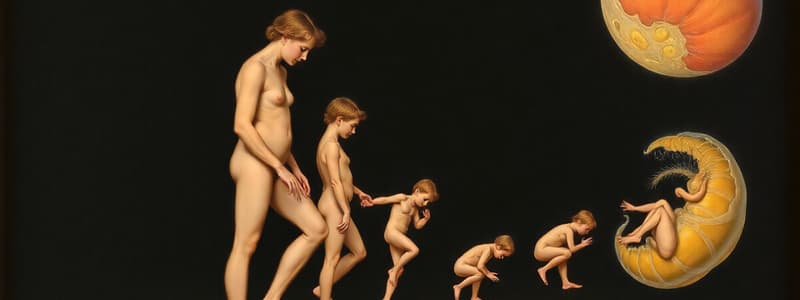Podcast
Questions and Answers
What is the main function of the allantois during embryonic development?
What is the main function of the allantois during embryonic development?
- Initially to collect liquid waste and facilitate gas exchange (correct)
- To contain fluid that surrounds the embryo
- To form villi for nutrient exchange with the mother
- To nourish the embryo during early pregnancy
Gametogenesis is the process where diploid cells transform into haploid cells.
Gametogenesis is the process where diploid cells transform into haploid cells.
True (A)
What is the role of the zona pellucida in fertilization?
What is the role of the zona pellucida in fertilization?
The zona pellucida is a layer that surrounds the egg and requires sperm to release enzymes to degrade it
The process of organ formation in the embryo is known as ______.
The process of organ formation in the embryo is known as ______.
Match the following extraembryonic membranes with their functions:
Match the following extraembryonic membranes with their functions:
Which of the following processes is essential for preventing fertilization by multiple sperm?
Which of the following processes is essential for preventing fertilization by multiple sperm?
The bulbourethral gland in females is homologous to the clitoris in males.
The bulbourethral gland in females is homologous to the clitoris in males.
What are the roles of the seminal vesicle and prostate gland in the male reproductive system?
What are the roles of the seminal vesicle and prostate gland in the male reproductive system?
The union of the sperm cell and egg cell results in the formation of a ______.
The union of the sperm cell and egg cell results in the formation of a ______.
During which stage of human development does the embryo become most susceptible to teratogens?
During which stage of human development does the embryo become most susceptible to teratogens?
Flashcards
Fertilization
Fertilization
The union of a sperm cell and an egg cell, initiating the development of a new individual.
Zygote
Zygote
The cell formed by the union of a sperm and an egg; the first stage of a new organism.
Embryo
Embryo
The stage of development after the zygote stage, characterized by rapid cell division and differentiation.
Fetus
Fetus
Signup and view all the flashcards
Gestation
Gestation
Signup and view all the flashcards
Infant
Infant
Signup and view all the flashcards
Puberty
Puberty
Signup and view all the flashcards
Gonads
Gonads
Signup and view all the flashcards
Gametogenesis
Gametogenesis
Signup and view all the flashcards
Inner cell mass
Inner cell mass
Signup and view all the flashcards
Study Notes
- Human life cycle begins with fertilization
- Followed by series of growth and development that allow formation of fully functional individual
- Male sperm cell unites with female egg cell during fertilization
- Gametes serve to combine paternal and maternal genetic material in offspring
- Fertilized egg (zygote) develops into an embryo through cell division and differentiation
Human Development
- Embryo develops into a fetus inside the womb
- Fetus obtains oxygen and nourishment through placenta
- Gestation period: ninth month of pregnancy
- Newborns (0-1 year old) are infants
- Infants continue developing functionality of organs like eyes and brain
Stages of Development
- Childhood: 1-12 years; locomotor and cognitive skills develop
- Adolescence: puberty prepares individual for adulthood (13-19 years)
- Puberty involves changes in body parts and functions and development of secondary sex traits
- Adulthood ensures transmission of genes to next generation
Adulthood Stages
- Young adults: 20–35 years old
- Middle-aged adults: 36–54 years old
- Elderly: 55-65 years old
Human Reproduction
- Exclusively sexual; involves production/fusion of sex cells (gametes)
- Fertilization ensures zygote formation
- Complete genetic instructions needed to grow into adult
Male Reproductive Structures
- Located in pelvic region
- Produce and convey male gametes
- Testes: primary reproductive glands, contained in scrotum (maintains temperature for sperm production)
- Sperm exits through vas deferens during ejaculation, ascends into abdomen, loops into urinary bladder, goes down into urethra
- Seminal vesicle: contributes 60% to semen, alkaline solution nourishes/protects sperm
- Prostate gland: 30% of semen, neutralizes pH of semen/vaginal fluids
- Bulbourethral gland: lubricating fluid for intercourse
- Penis: male organ for erection and semen expulsion.
Female Reproductive Structures
- Female reproductive system also in pelvic region
- Ovaries: produce eggs
- Fallopian tubes (oviducts): catch eggs
- Fimbriae: finger-like appendages
- Uterus (womb): chamber with vascularized endometrium to house/nourish embryo; muscular layer expels baby during labor
- Vagina: receives penis during intercourse, Elastic channel (birth canal)
- Cervix: prevents entry of foreign materials to the uterus
- Clitoris: homologous to penis; functions for sexual stimulation
Gametogenesis
- Testes and ovaries (gonads) produce gametes and nourish sex cells
- Gametogenesis: diploid chromosome set of precursor cells reduced to haploid
Fertilization Process
- Male releases sperm (spermatozoa) during copulation/intercourse
- Sperm travels to fallopian tube to meet egg cell
- Fertilization: fusion of sperm and egg cells forms diploid zygote
- Sperm uses motility to reach egg cell
- Fertilization: sperm penetrates between granulosa cells, then passes through zona pellucida
Egg Cell Layers
- Granulosa cells protect/nourish egg during development
- Acrosomal enzymes degrade zona pellucida (jelly coat layer)
- Membranes of sperm and egg fuse, paternal genetic material combines
Polyspermy Prevention
- Fast-block mechanism: Electrical charge changes within egg cell membrane
- Slow-block mechanism: Cortical granule reaction facilitates fertilization membrane formation
Human Development: Pre-Implantation
- Zygote travels to uterus, implanted, develops into human
- Preimplantation/germinal stage: fertilized egg travels to uterus, undergoes a series of mitotic cell divisions
- This is called germinal embryonic development
Cell division
- Two-cell, four-cell, eight-cell stages occur
- Morula stage: 16-cell phase; arrives in uterus three days post-fertilization
- Blastocyst: ball of cells developed by the continued division of the Zygote
- Trophoblast: outer shell; develops into chorionic sac and fetal portion of placenta
- Trophoblast and the inner mass develops into the chorionic sac and the fetal function of the placenta
Cellular Differentiation
- Trophoblast cells undergo differentiation forming connections between developing embryo and uterine wall during eighth/ninth day (embryonic implantation)
- Connects embryo to the womb, supplies blood and nutrients until birth
Extraembryonic Membranes and Placental Development:
- During the second week, Embryonic implanted cells form extraembryonic membranes
- These consist of the: amnion, yolk sac, allantois, and chorion
- Membranes support and protect the growing embryo
Extraembryonic Membrane Facts
- Amnion: contains fluid to surround the embryo; found in amniotes
- Yolk sac: provides initial nourishment in early pregnancy
- Allantois: collects liquid waste, facilitates gas exchange; forms umbilical cord along with yolk sac
- Chorion: allows villi to exchange nutrients, oxygen, and waste with mother
Third Week of Development (Gastrulation Stage)
- The embryo becomes a three layered disc of cells through the process of gastrulation
- The embryo becomes an oval-shaped disc
- The three germ layers (formed after gastrulation) developing into specific tissues and organs in the embryo.
- At four to twelve weeks During the prenatal period the placenta develops allowing the feeding of the developing embryo
- The Placenta derived from the tissues of the embryo and maternal tissues connected to developing through the umbilical cord
- Networks facilitate the transfer of material between the baby and the mother
Embryonic Development
- Embryo becomes susceptible to teratogens at embryonic stage, which induces developmental defects
- Organogenesis: organ formation starts in third week after fertilization; heart develops
- Limbs rotate, fingers separate, sex determined, and face becomes human
Fetal Development
- At fourth week, eyes, arms, legs become prominent, embryo size increases
- External genitalia form during eighth/ninth weeks predicts Phenotypic sex through ultrasound
- Further active organ formation occurs from ninth to thirty-eighth weeks of pregnancy and formation of different organs
Studying That Suits You
Use AI to generate personalized quizzes and flashcards to suit your learning preferences.




